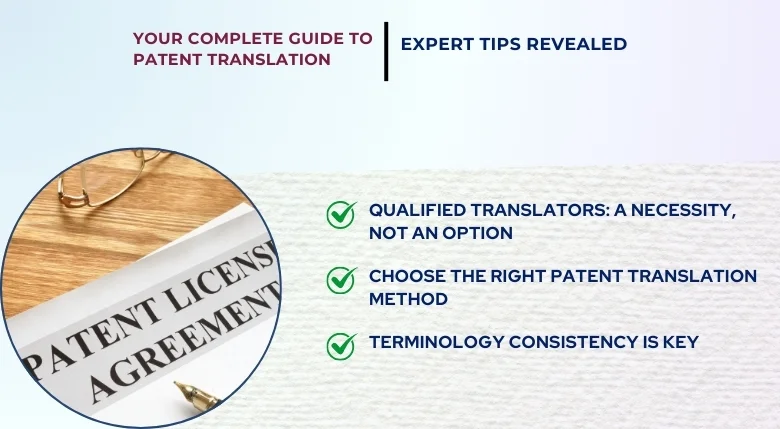 Patents are invaluable assets that protect inventions, innovations, and breakthroughs across various industries. Securing patents allows inventors and businesses to safeguard their intellectual property, prevent unauthorized use, and enjoy exclusive rights to their creations. However, navigating the complexities of international patent protection requires meticulous attention to detail, especially in patent translation.
Patents are invaluable assets that protect inventions, innovations, and breakthroughs across various industries. Securing patents allows inventors and businesses to safeguard their intellectual property, prevent unauthorized use, and enjoy exclusive rights to their creations. However, navigating the complexities of international patent protection requires meticulous attention to detail, especially in patent translation.
The Importance of Patent Translation
Patent translation is necessary for protecting an inventor’s rights and ensuring the patent’s validity in different jurisdictions. As the global marketplace expands, the need for accurate and effective patent translation services becomes even more apparent. With patents often covering highly technical and specialized subject matter, accurate translation is essential to preserve the original meaning and scope of the invention.
Qualified Translators: A Necessity, Not an Option
Regarding patent translation, hiring qualified translators with subject matter expertise is non-negotiable. Patent documents often contain intricate technical language and legal terminology, necessitating a deep understanding of the subject matter and the legal framework. Qualified translators possess the necessary linguistic skills, industry knowledge, and expertise to deliver precise and reliable translations.
Read about the significance of medical interpretation.
Context Matters: Understanding the Invention
An accurate patent translation goes beyond translating individual words; it involves understanding the context and functionality of the invention. Translators should familiarize themselves with the technical aspects of the invention, its purpose, and its potential applications. This in-depth understanding ensures the translation accurately reflects the original patent’s intent and scope.
Choose the Right Patent Translation Method
There are two primary patent translation methods: direct and indirect. Direct translation involves translating the patent into the target language without altering its structure or content. On the other hand, indirect translation involves rephrasing and restructuring the patent to fit the linguistic and legal norms of the target country. The method choice depends on each case’s specific requirements and the target audience.
Know more about Data Annotations Trends 2023.
Localization: Adapting to Local Legal Systems
When translating patents for international markets, localization plays a vital role. This process involves adapting the translation to comply with the legal and technical norms of the target country’s patent system. Patent laws can vary significantly from one jurisdiction to another, and a well-localized translation ensures that the patent is enforceable and valid in the desired market.
Terminology Consistency is Key
In patent translation, consistency in terminology is paramount. Standardized terminology ensures the translated patent is accurate and unambiguous, reducing the risk of misunderstandings or misinterpretations. Creating and maintaining a comprehensive glossary of key terms helps maintain consistency throughout the translation process.
Preserve Patent Structure and Formatting
A well-structured patent is easier to understand and navigate. When translating a patent, preserving the original document’s structure and formatting is essential. Translators must pay attention to headings, subheadings, and other formatting elements to ensure that the translated version remains organized and accessible.
Get affordable MTPE services from us.
Legal and Cultural Nuances
Translating legal documents like patents requires understanding the legal systems and cultural nuances of both the source and target languages. Legal terms and concepts can have distinct meanings in different jurisdictions, and translators need to navigate these intricacies carefully to avoid misinterpretations.
Proofreading and Quality Assurance
Thorough proofreading and quality assurance are vital in patent translation. Even the minute error can have significant consequences, potentially leading to the rejection of the patent application. Employing a team of qualified linguists and subject matter experts for proofreading guarantees high accuracy and minimizes the risk of errors.
Confidentiality and Security
Patent documents contain sensitive and proprietary information, making confidentiality and security paramount. When selecting a prominent translation service in India, ensure they have robust data protection measures to safeguard your intellectual property.
In conclusion, patent translation is a specialized and critical process that requires the expertise of qualified translators, subject matter experts, and a deep understanding of the legal and technical side of the invention. Following the expert tips in this guide, you can ensure accurate, reliable, and effective patent translations that protect your intellectual property and enable successful international patent protection. Remember, investing in high-quality patent translation is an investment in your innovation’s future while also considering localizing your marketing content to reach wider audiences.







